MG625: Leading and Managing Change: Café 13 Case Study Report
VerifiedAdded on 2023/01/09
|8
|2164
|50
Report
AI Summary
This report examines the challenges faced in implementing cultural change within Café 13, focusing on the difficulties arising from a new manager's introduction of rapid changes. It analyzes the resistance to change stemming from cultural differences, employee age, and the lack of a planned approach. The report highlights the importance of a slower, more strategic approach to change implementation, emphasizing the need for the manager to build rapport with employees, communicate the benefits of change, and address the existing organizational culture. Furthermore, it suggests adopting the Kurt Lewin Model of Change Management (Unfreezing, Changing, Freezing) to facilitate a phased and structured transition. The report concludes that a planned approach, incorporating employee understanding and training, is crucial for successful cultural change and improved organizational performance at Café 13.
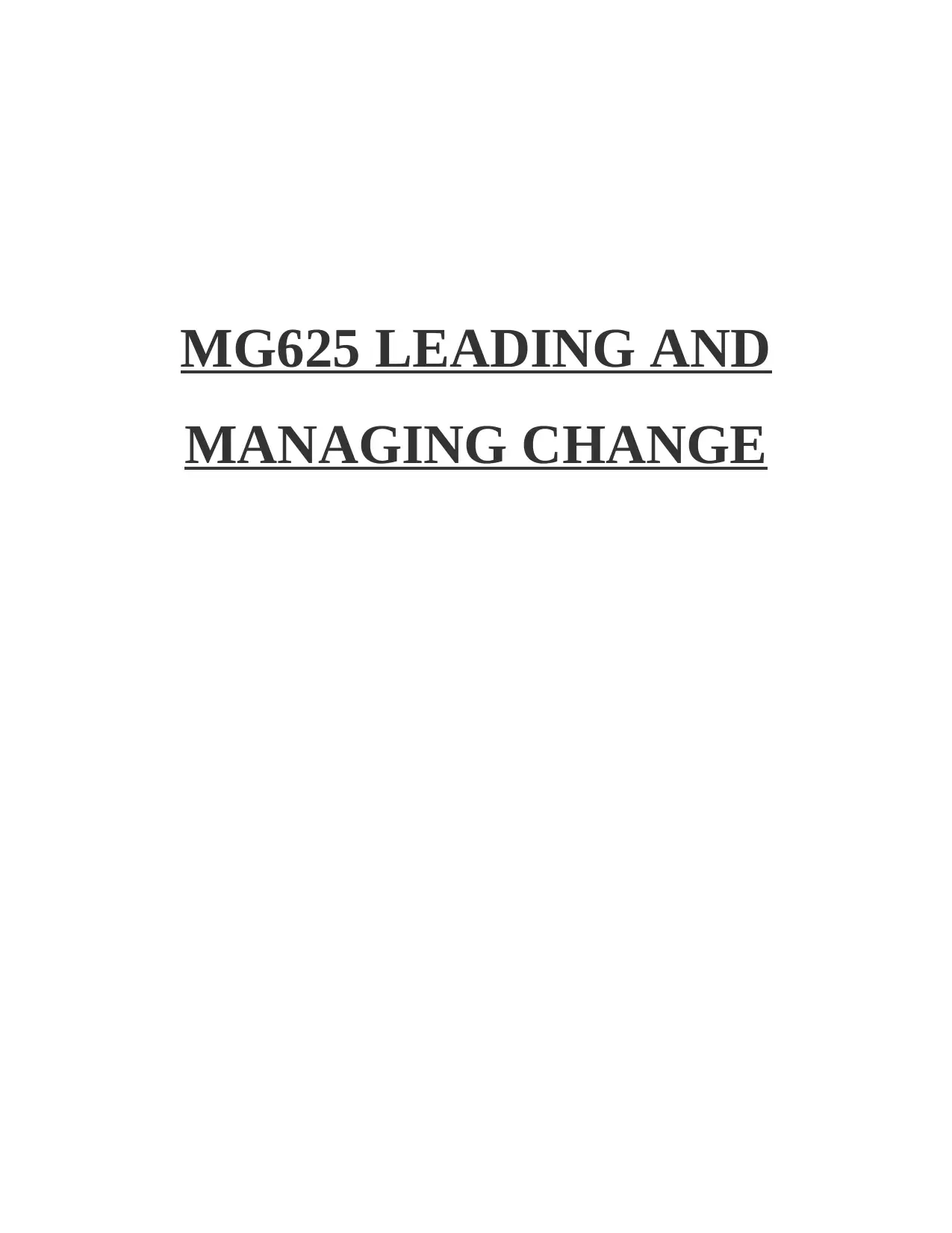
MG625 LEADING AND
MANAGING CHANGE
MANAGING CHANGE
Paraphrase This Document
Need a fresh take? Get an instant paraphrase of this document with our AI Paraphraser
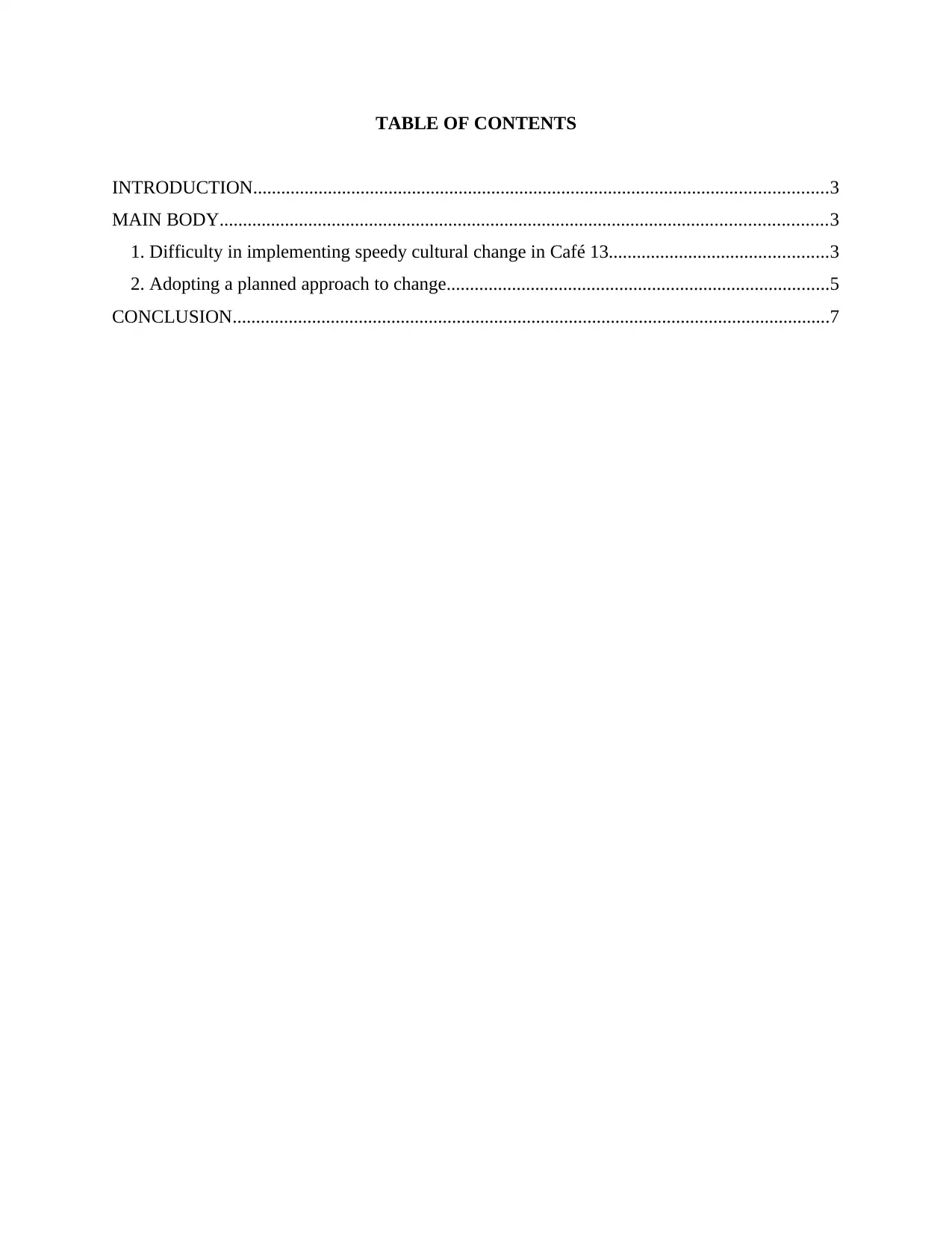
TABLE OF CONTENTS
INTRODUCTION...........................................................................................................................3
MAIN BODY..................................................................................................................................3
1. Difficulty in implementing speedy cultural change in Café 13...............................................3
2. Adopting a planned approach to change..................................................................................5
CONCLUSION................................................................................................................................7
INTRODUCTION...........................................................................................................................3
MAIN BODY..................................................................................................................................3
1. Difficulty in implementing speedy cultural change in Café 13...............................................3
2. Adopting a planned approach to change..................................................................................5
CONCLUSION................................................................................................................................7
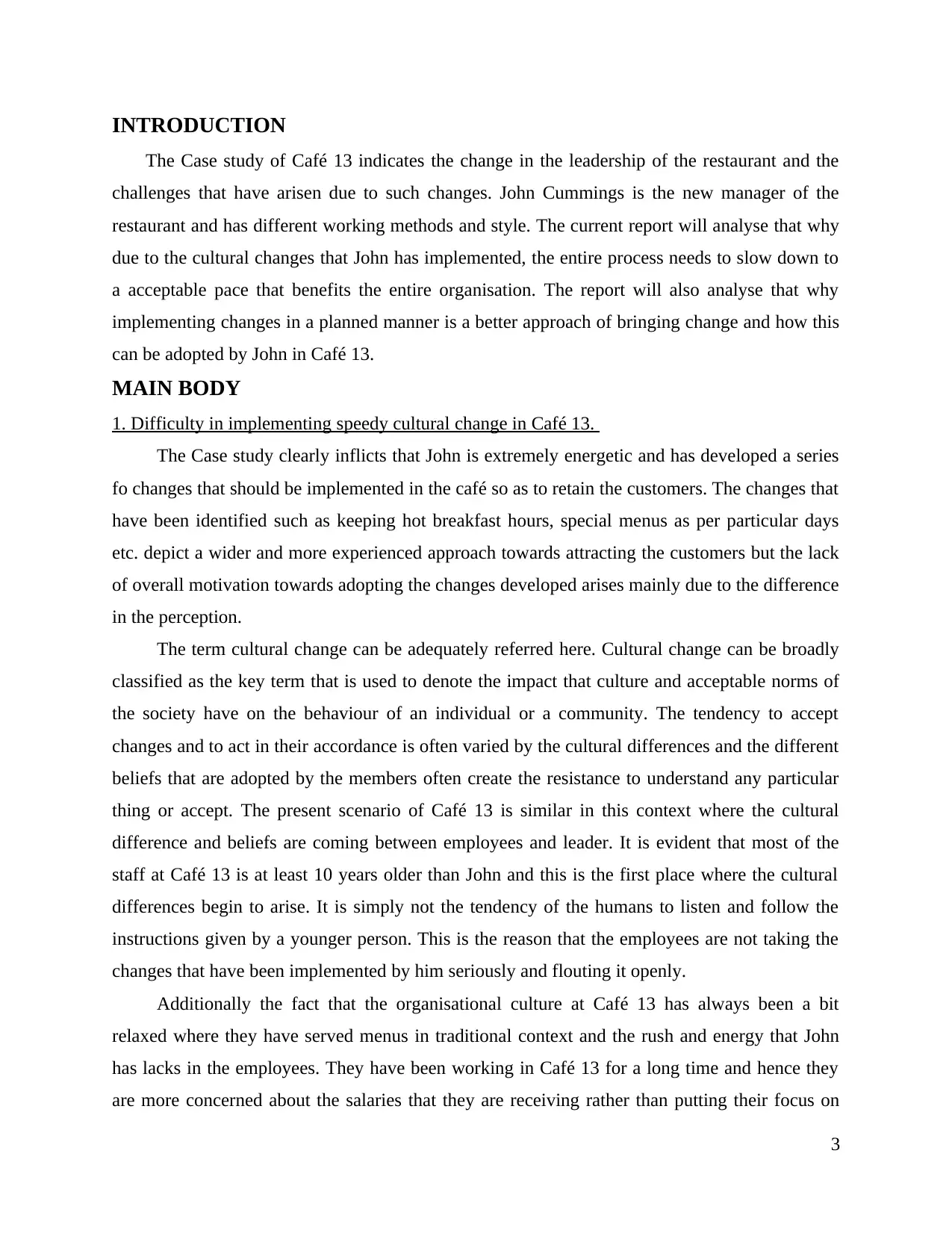
INTRODUCTION
The Case study of Café 13 indicates the change in the leadership of the restaurant and the
challenges that have arisen due to such changes. John Cummings is the new manager of the
restaurant and has different working methods and style. The current report will analyse that why
due to the cultural changes that John has implemented, the entire process needs to slow down to
a acceptable pace that benefits the entire organisation. The report will also analyse that why
implementing changes in a planned manner is a better approach of bringing change and how this
can be adopted by John in Café 13.
MAIN BODY
1. Difficulty in implementing speedy cultural change in Café 13.
The Case study clearly inflicts that John is extremely energetic and has developed a series
fo changes that should be implemented in the café so as to retain the customers. The changes that
have been identified such as keeping hot breakfast hours, special menus as per particular days
etc. depict a wider and more experienced approach towards attracting the customers but the lack
of overall motivation towards adopting the changes developed arises mainly due to the difference
in the perception.
The term cultural change can be adequately referred here. Cultural change can be broadly
classified as the key term that is used to denote the impact that culture and acceptable norms of
the society have on the behaviour of an individual or a community. The tendency to accept
changes and to act in their accordance is often varied by the cultural differences and the different
beliefs that are adopted by the members often create the resistance to understand any particular
thing or accept. The present scenario of Café 13 is similar in this context where the cultural
difference and beliefs are coming between employees and leader. It is evident that most of the
staff at Café 13 is at least 10 years older than John and this is the first place where the cultural
differences begin to arise. It is simply not the tendency of the humans to listen and follow the
instructions given by a younger person. This is the reason that the employees are not taking the
changes that have been implemented by him seriously and flouting it openly.
Additionally the fact that the organisational culture at Café 13 has always been a bit
relaxed where they have served menus in traditional context and the rush and energy that John
has lacks in the employees. They have been working in Café 13 for a long time and hence they
are more concerned about the salaries that they are receiving rather than putting their focus on
3
The Case study of Café 13 indicates the change in the leadership of the restaurant and the
challenges that have arisen due to such changes. John Cummings is the new manager of the
restaurant and has different working methods and style. The current report will analyse that why
due to the cultural changes that John has implemented, the entire process needs to slow down to
a acceptable pace that benefits the entire organisation. The report will also analyse that why
implementing changes in a planned manner is a better approach of bringing change and how this
can be adopted by John in Café 13.
MAIN BODY
1. Difficulty in implementing speedy cultural change in Café 13.
The Case study clearly inflicts that John is extremely energetic and has developed a series
fo changes that should be implemented in the café so as to retain the customers. The changes that
have been identified such as keeping hot breakfast hours, special menus as per particular days
etc. depict a wider and more experienced approach towards attracting the customers but the lack
of overall motivation towards adopting the changes developed arises mainly due to the difference
in the perception.
The term cultural change can be adequately referred here. Cultural change can be broadly
classified as the key term that is used to denote the impact that culture and acceptable norms of
the society have on the behaviour of an individual or a community. The tendency to accept
changes and to act in their accordance is often varied by the cultural differences and the different
beliefs that are adopted by the members often create the resistance to understand any particular
thing or accept. The present scenario of Café 13 is similar in this context where the cultural
difference and beliefs are coming between employees and leader. It is evident that most of the
staff at Café 13 is at least 10 years older than John and this is the first place where the cultural
differences begin to arise. It is simply not the tendency of the humans to listen and follow the
instructions given by a younger person. This is the reason that the employees are not taking the
changes that have been implemented by him seriously and flouting it openly.
Additionally the fact that the organisational culture at Café 13 has always been a bit
relaxed where they have served menus in traditional context and the rush and energy that John
has lacks in the employees. They have been working in Café 13 for a long time and hence they
are more concerned about the salaries that they are receiving rather than putting their focus on
3
⊘ This is a preview!⊘
Do you want full access?
Subscribe today to unlock all pages.

Trusted by 1+ million students worldwide
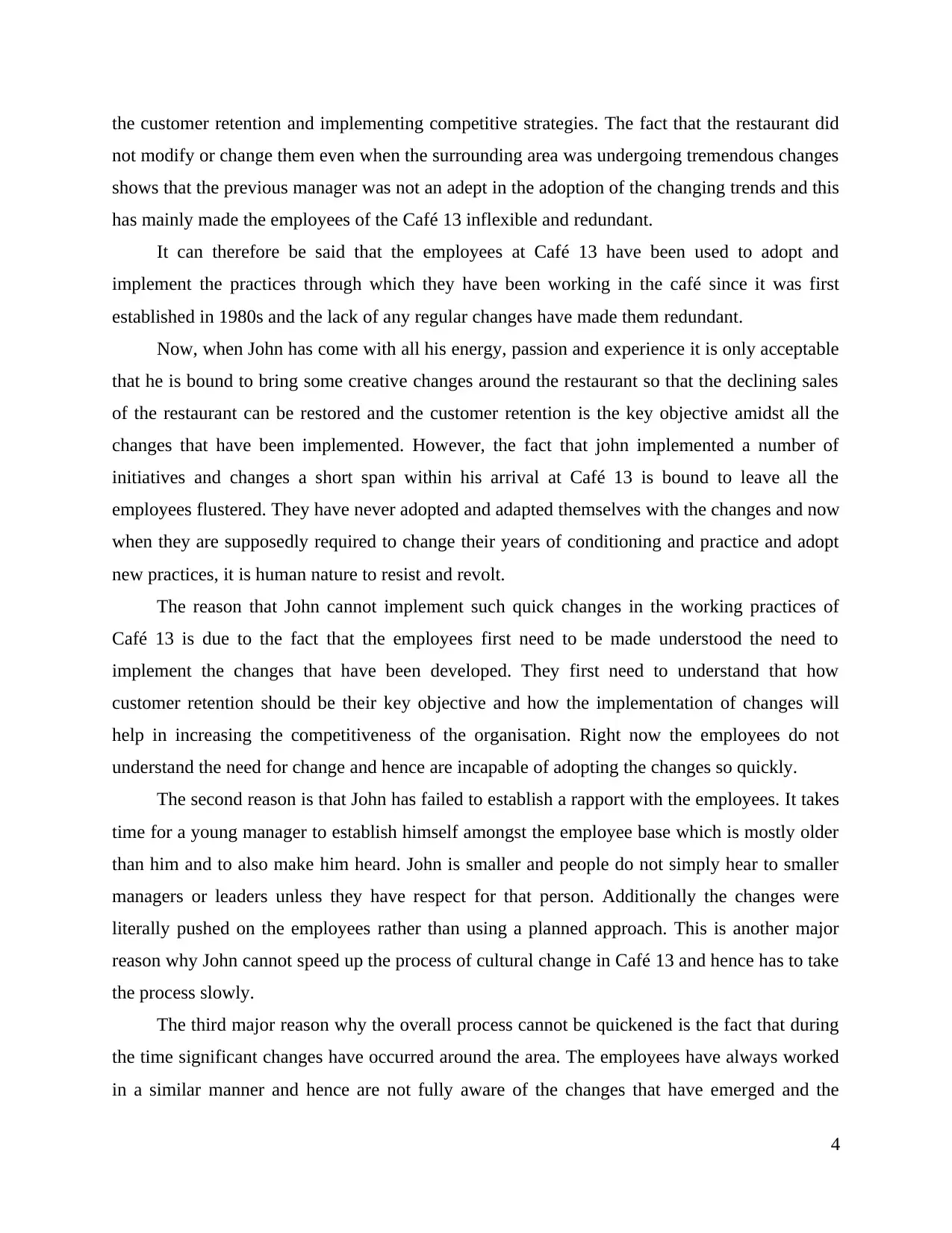
the customer retention and implementing competitive strategies. The fact that the restaurant did
not modify or change them even when the surrounding area was undergoing tremendous changes
shows that the previous manager was not an adept in the adoption of the changing trends and this
has mainly made the employees of the Café 13 inflexible and redundant.
It can therefore be said that the employees at Café 13 have been used to adopt and
implement the practices through which they have been working in the café since it was first
established in 1980s and the lack of any regular changes have made them redundant.
Now, when John has come with all his energy, passion and experience it is only acceptable
that he is bound to bring some creative changes around the restaurant so that the declining sales
of the restaurant can be restored and the customer retention is the key objective amidst all the
changes that have been implemented. However, the fact that john implemented a number of
initiatives and changes a short span within his arrival at Café 13 is bound to leave all the
employees flustered. They have never adopted and adapted themselves with the changes and now
when they are supposedly required to change their years of conditioning and practice and adopt
new practices, it is human nature to resist and revolt.
The reason that John cannot implement such quick changes in the working practices of
Café 13 is due to the fact that the employees first need to be made understood the need to
implement the changes that have been developed. They first need to understand that how
customer retention should be their key objective and how the implementation of changes will
help in increasing the competitiveness of the organisation. Right now the employees do not
understand the need for change and hence are incapable of adopting the changes so quickly.
The second reason is that John has failed to establish a rapport with the employees. It takes
time for a young manager to establish himself amongst the employee base which is mostly older
than him and to also make him heard. John is smaller and people do not simply hear to smaller
managers or leaders unless they have respect for that person. Additionally the changes were
literally pushed on the employees rather than using a planned approach. This is another major
reason why John cannot speed up the process of cultural change in Café 13 and hence has to take
the process slowly.
The third major reason why the overall process cannot be quickened is the fact that during
the time significant changes have occurred around the area. The employees have always worked
in a similar manner and hence are not fully aware of the changes that have emerged and the
4
not modify or change them even when the surrounding area was undergoing tremendous changes
shows that the previous manager was not an adept in the adoption of the changing trends and this
has mainly made the employees of the Café 13 inflexible and redundant.
It can therefore be said that the employees at Café 13 have been used to adopt and
implement the practices through which they have been working in the café since it was first
established in 1980s and the lack of any regular changes have made them redundant.
Now, when John has come with all his energy, passion and experience it is only acceptable
that he is bound to bring some creative changes around the restaurant so that the declining sales
of the restaurant can be restored and the customer retention is the key objective amidst all the
changes that have been implemented. However, the fact that john implemented a number of
initiatives and changes a short span within his arrival at Café 13 is bound to leave all the
employees flustered. They have never adopted and adapted themselves with the changes and now
when they are supposedly required to change their years of conditioning and practice and adopt
new practices, it is human nature to resist and revolt.
The reason that John cannot implement such quick changes in the working practices of
Café 13 is due to the fact that the employees first need to be made understood the need to
implement the changes that have been developed. They first need to understand that how
customer retention should be their key objective and how the implementation of changes will
help in increasing the competitiveness of the organisation. Right now the employees do not
understand the need for change and hence are incapable of adopting the changes so quickly.
The second reason is that John has failed to establish a rapport with the employees. It takes
time for a young manager to establish himself amongst the employee base which is mostly older
than him and to also make him heard. John is smaller and people do not simply hear to smaller
managers or leaders unless they have respect for that person. Additionally the changes were
literally pushed on the employees rather than using a planned approach. This is another major
reason why John cannot speed up the process of cultural change in Café 13 and hence has to take
the process slowly.
The third major reason why the overall process cannot be quickened is the fact that during
the time significant changes have occurred around the area. The employees have always worked
in a similar manner and hence are not fully aware of the changes that have emerged and the
4
Paraphrase This Document
Need a fresh take? Get an instant paraphrase of this document with our AI Paraphraser
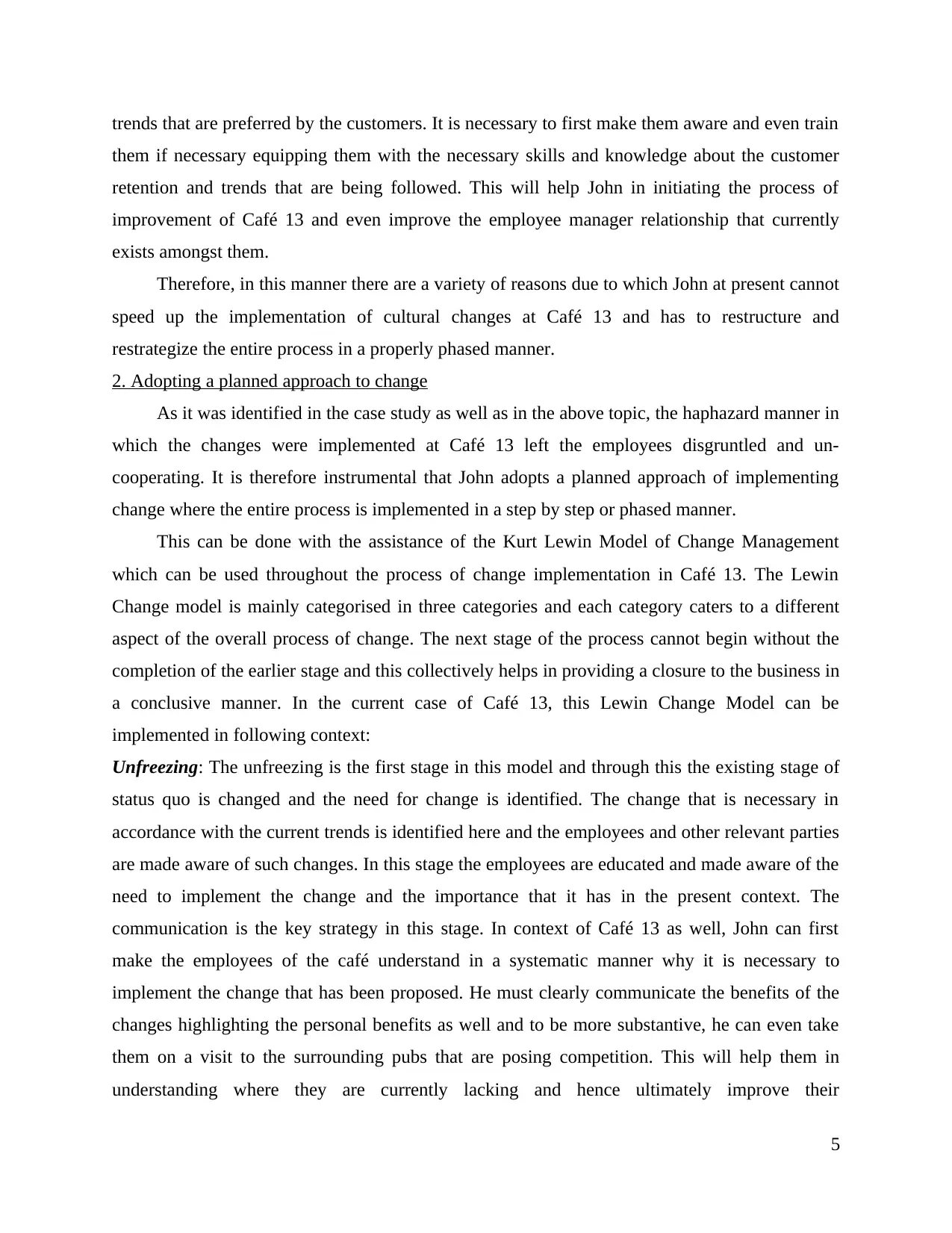
trends that are preferred by the customers. It is necessary to first make them aware and even train
them if necessary equipping them with the necessary skills and knowledge about the customer
retention and trends that are being followed. This will help John in initiating the process of
improvement of Café 13 and even improve the employee manager relationship that currently
exists amongst them.
Therefore, in this manner there are a variety of reasons due to which John at present cannot
speed up the implementation of cultural changes at Café 13 and has to restructure and
restrategize the entire process in a properly phased manner.
2. Adopting a planned approach to change
As it was identified in the case study as well as in the above topic, the haphazard manner in
which the changes were implemented at Café 13 left the employees disgruntled and un-
cooperating. It is therefore instrumental that John adopts a planned approach of implementing
change where the entire process is implemented in a step by step or phased manner.
This can be done with the assistance of the Kurt Lewin Model of Change Management
which can be used throughout the process of change implementation in Café 13. The Lewin
Change model is mainly categorised in three categories and each category caters to a different
aspect of the overall process of change. The next stage of the process cannot begin without the
completion of the earlier stage and this collectively helps in providing a closure to the business in
a conclusive manner. In the current case of Café 13, this Lewin Change Model can be
implemented in following context:
Unfreezing: The unfreezing is the first stage in this model and through this the existing stage of
status quo is changed and the need for change is identified. The change that is necessary in
accordance with the current trends is identified here and the employees and other relevant parties
are made aware of such changes. In this stage the employees are educated and made aware of the
need to implement the change and the importance that it has in the present context. The
communication is the key strategy in this stage. In context of Café 13 as well, John can first
make the employees of the café understand in a systematic manner why it is necessary to
implement the change that has been proposed. He must clearly communicate the benefits of the
changes highlighting the personal benefits as well and to be more substantive, he can even take
them on a visit to the surrounding pubs that are posing competition. This will help them in
understanding where they are currently lacking and hence ultimately improve their
5
them if necessary equipping them with the necessary skills and knowledge about the customer
retention and trends that are being followed. This will help John in initiating the process of
improvement of Café 13 and even improve the employee manager relationship that currently
exists amongst them.
Therefore, in this manner there are a variety of reasons due to which John at present cannot
speed up the implementation of cultural changes at Café 13 and has to restructure and
restrategize the entire process in a properly phased manner.
2. Adopting a planned approach to change
As it was identified in the case study as well as in the above topic, the haphazard manner in
which the changes were implemented at Café 13 left the employees disgruntled and un-
cooperating. It is therefore instrumental that John adopts a planned approach of implementing
change where the entire process is implemented in a step by step or phased manner.
This can be done with the assistance of the Kurt Lewin Model of Change Management
which can be used throughout the process of change implementation in Café 13. The Lewin
Change model is mainly categorised in three categories and each category caters to a different
aspect of the overall process of change. The next stage of the process cannot begin without the
completion of the earlier stage and this collectively helps in providing a closure to the business in
a conclusive manner. In the current case of Café 13, this Lewin Change Model can be
implemented in following context:
Unfreezing: The unfreezing is the first stage in this model and through this the existing stage of
status quo is changed and the need for change is identified. The change that is necessary in
accordance with the current trends is identified here and the employees and other relevant parties
are made aware of such changes. In this stage the employees are educated and made aware of the
need to implement the change and the importance that it has in the present context. The
communication is the key strategy in this stage. In context of Café 13 as well, John can first
make the employees of the café understand in a systematic manner why it is necessary to
implement the change that has been proposed. He must clearly communicate the benefits of the
changes highlighting the personal benefits as well and to be more substantive, he can even take
them on a visit to the surrounding pubs that are posing competition. This will help them in
understanding where they are currently lacking and hence ultimately improve their
5
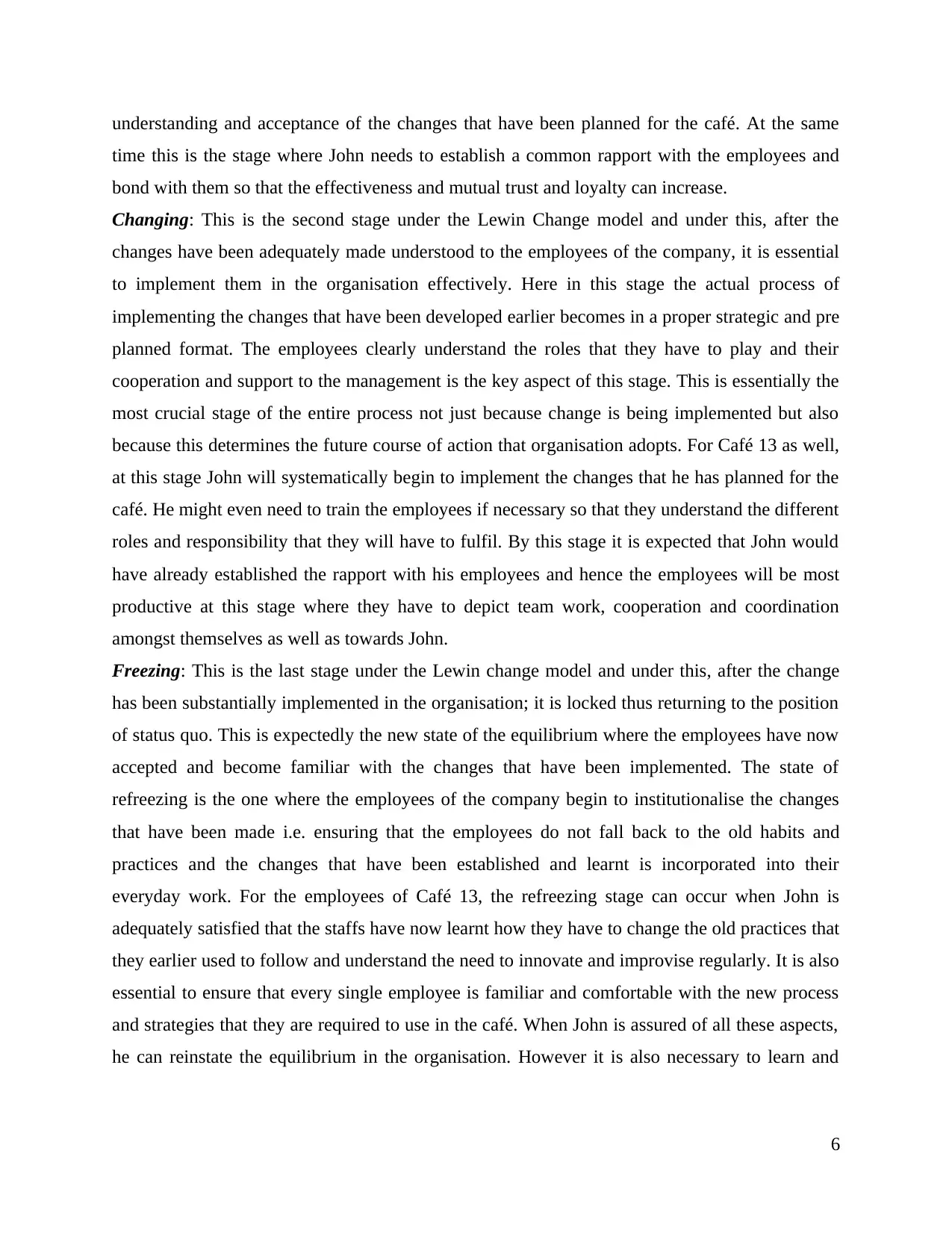
understanding and acceptance of the changes that have been planned for the café. At the same
time this is the stage where John needs to establish a common rapport with the employees and
bond with them so that the effectiveness and mutual trust and loyalty can increase.
Changing: This is the second stage under the Lewin Change model and under this, after the
changes have been adequately made understood to the employees of the company, it is essential
to implement them in the organisation effectively. Here in this stage the actual process of
implementing the changes that have been developed earlier becomes in a proper strategic and pre
planned format. The employees clearly understand the roles that they have to play and their
cooperation and support to the management is the key aspect of this stage. This is essentially the
most crucial stage of the entire process not just because change is being implemented but also
because this determines the future course of action that organisation adopts. For Café 13 as well,
at this stage John will systematically begin to implement the changes that he has planned for the
café. He might even need to train the employees if necessary so that they understand the different
roles and responsibility that they will have to fulfil. By this stage it is expected that John would
have already established the rapport with his employees and hence the employees will be most
productive at this stage where they have to depict team work, cooperation and coordination
amongst themselves as well as towards John.
Freezing: This is the last stage under the Lewin change model and under this, after the change
has been substantially implemented in the organisation; it is locked thus returning to the position
of status quo. This is expectedly the new state of the equilibrium where the employees have now
accepted and become familiar with the changes that have been implemented. The state of
refreezing is the one where the employees of the company begin to institutionalise the changes
that have been made i.e. ensuring that the employees do not fall back to the old habits and
practices and the changes that have been established and learnt is incorporated into their
everyday work. For the employees of Café 13, the refreezing stage can occur when John is
adequately satisfied that the staffs have now learnt how they have to change the old practices that
they earlier used to follow and understand the need to innovate and improvise regularly. It is also
essential to ensure that every single employee is familiar and comfortable with the new process
and strategies that they are required to use in the café. When John is assured of all these aspects,
he can reinstate the equilibrium in the organisation. However it is also necessary to learn and
6
time this is the stage where John needs to establish a common rapport with the employees and
bond with them so that the effectiveness and mutual trust and loyalty can increase.
Changing: This is the second stage under the Lewin Change model and under this, after the
changes have been adequately made understood to the employees of the company, it is essential
to implement them in the organisation effectively. Here in this stage the actual process of
implementing the changes that have been developed earlier becomes in a proper strategic and pre
planned format. The employees clearly understand the roles that they have to play and their
cooperation and support to the management is the key aspect of this stage. This is essentially the
most crucial stage of the entire process not just because change is being implemented but also
because this determines the future course of action that organisation adopts. For Café 13 as well,
at this stage John will systematically begin to implement the changes that he has planned for the
café. He might even need to train the employees if necessary so that they understand the different
roles and responsibility that they will have to fulfil. By this stage it is expected that John would
have already established the rapport with his employees and hence the employees will be most
productive at this stage where they have to depict team work, cooperation and coordination
amongst themselves as well as towards John.
Freezing: This is the last stage under the Lewin change model and under this, after the change
has been substantially implemented in the organisation; it is locked thus returning to the position
of status quo. This is expectedly the new state of the equilibrium where the employees have now
accepted and become familiar with the changes that have been implemented. The state of
refreezing is the one where the employees of the company begin to institutionalise the changes
that have been made i.e. ensuring that the employees do not fall back to the old habits and
practices and the changes that have been established and learnt is incorporated into their
everyday work. For the employees of Café 13, the refreezing stage can occur when John is
adequately satisfied that the staffs have now learnt how they have to change the old practices that
they earlier used to follow and understand the need to innovate and improvise regularly. It is also
essential to ensure that every single employee is familiar and comfortable with the new process
and strategies that they are required to use in the café. When John is assured of all these aspects,
he can reinstate the equilibrium in the organisation. However it is also necessary to learn and
6
⊘ This is a preview!⊘
Do you want full access?
Subscribe today to unlock all pages.

Trusted by 1+ million students worldwide
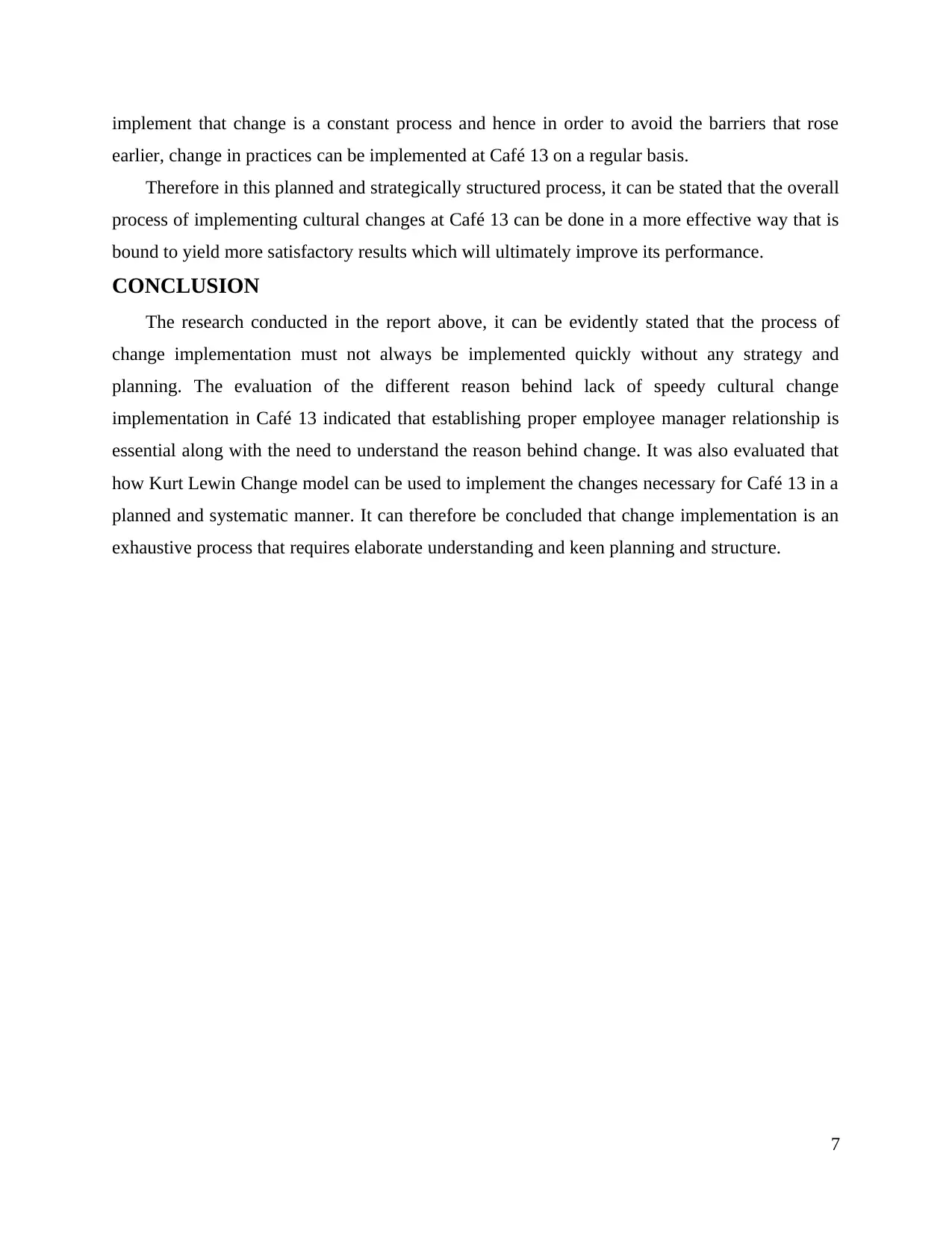
implement that change is a constant process and hence in order to avoid the barriers that rose
earlier, change in practices can be implemented at Café 13 on a regular basis.
Therefore in this planned and strategically structured process, it can be stated that the overall
process of implementing cultural changes at Café 13 can be done in a more effective way that is
bound to yield more satisfactory results which will ultimately improve its performance.
CONCLUSION
The research conducted in the report above, it can be evidently stated that the process of
change implementation must not always be implemented quickly without any strategy and
planning. The evaluation of the different reason behind lack of speedy cultural change
implementation in Café 13 indicated that establishing proper employee manager relationship is
essential along with the need to understand the reason behind change. It was also evaluated that
how Kurt Lewin Change model can be used to implement the changes necessary for Café 13 in a
planned and systematic manner. It can therefore be concluded that change implementation is an
exhaustive process that requires elaborate understanding and keen planning and structure.
7
earlier, change in practices can be implemented at Café 13 on a regular basis.
Therefore in this planned and strategically structured process, it can be stated that the overall
process of implementing cultural changes at Café 13 can be done in a more effective way that is
bound to yield more satisfactory results which will ultimately improve its performance.
CONCLUSION
The research conducted in the report above, it can be evidently stated that the process of
change implementation must not always be implemented quickly without any strategy and
planning. The evaluation of the different reason behind lack of speedy cultural change
implementation in Café 13 indicated that establishing proper employee manager relationship is
essential along with the need to understand the reason behind change. It was also evaluated that
how Kurt Lewin Change model can be used to implement the changes necessary for Café 13 in a
planned and systematic manner. It can therefore be concluded that change implementation is an
exhaustive process that requires elaborate understanding and keen planning and structure.
7
Paraphrase This Document
Need a fresh take? Get an instant paraphrase of this document with our AI Paraphraser

8
1 out of 8
Related Documents
Your All-in-One AI-Powered Toolkit for Academic Success.
+13062052269
info@desklib.com
Available 24*7 on WhatsApp / Email
![[object Object]](/_next/static/media/star-bottom.7253800d.svg)
Unlock your academic potential
Copyright © 2020–2025 A2Z Services. All Rights Reserved. Developed and managed by ZUCOL.





